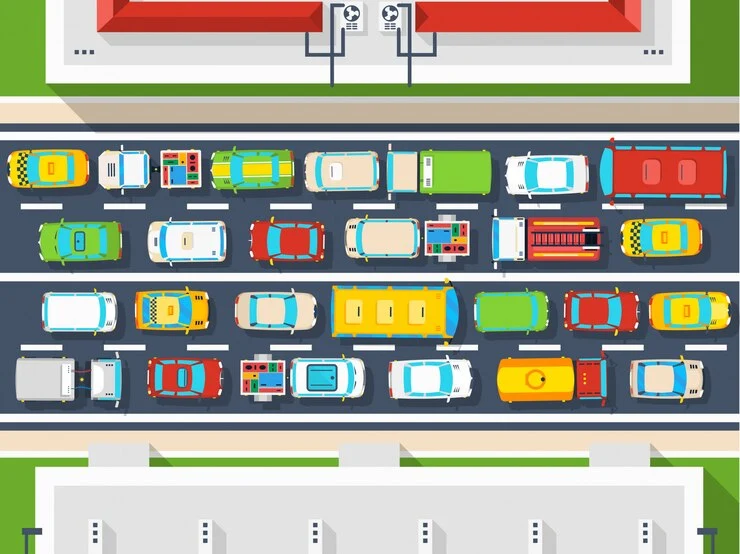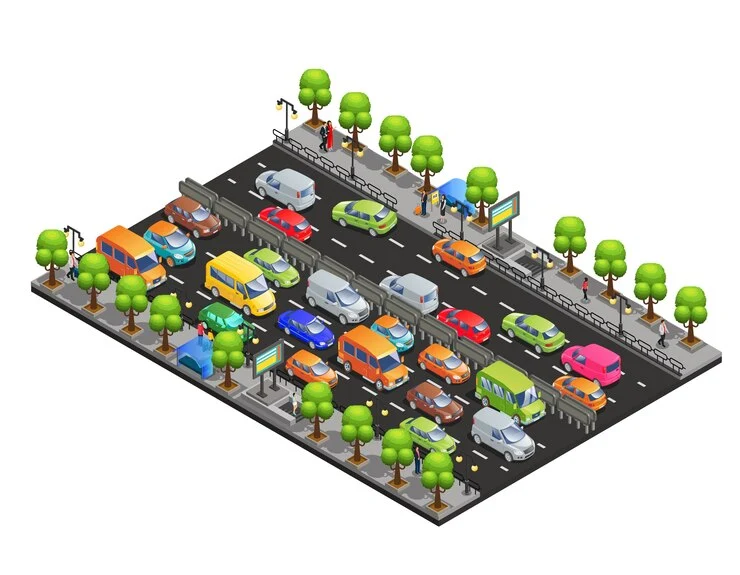Introduction Annual Average Daily Traffic (AADT)
Annual Average Daily Traffic (AADT) is a crucial metric in Traffic engineering and urban planning. It represents the average variety of vehicles passing a selected factor on a road over the course of a year.
This article explores how AADT works, also its reason and the role of modern-day technology, inclusive of big information.
in enhancing its accuracy and application. We additionally look into how services like Live Traffic Counter are presenting precious AADT facts in areas like the UAE and Saudi Arabia.
AADT stands for Annual Average Daily Traffic, a key metric used to determine the common variety of vehicles passing a point day by day over a year. also It topics because it allows for transportation planning, infrastructure improvement, and visitors management. also Big facts makes AADT more powerful through enhancing its accuracy and offering actual-time insights through significant records series and superior analytics.
AADT is an important metric in transportation that measures average day by day traffic over a yr.
It aids in infrastructure making plans, visitors management, and also safety tests. Enhancement through Big Data: Big facts improves AADT accuracy and presents deeper insights through actual-time analytics and broader records sources.

what is Annual Average Daily Traffic AADT?
Infrastructure Planning:
AADT information enabled within the layout and planning of street networks, with the expected quantity of site visitors.
Traffic Management:
It aids in the development of site visitors management strategies to lessen congestion and improve protection.
Funding and Resource Allocation:
Government businesses use AADT to allocate investment and sources for street protection and upgrades.
Economic Analysis:
It helps financial studies associated with shipping, including the evaluation of recent industrial developments.

How to Calculate Annual Average Daily Traffic AADT?
Calculating Annual Average Daily Traffic (AADT) entails measuring the entire extent of vehicle traffic on a avenue over a complete. 12 months and then dividing that total by one year This procedure typically starts off with gathering visitors records.
via numerous counting techniques, together with automated site visitors counters or manual surveys, over exclusive periods.
These numbers are then adjusted to account for seasonal releases, holidays, and other factors that might affect traffic that running. also Adjusted daily traffic volumes are summed over 12 months and divided by 365 to obtain the AADT, which offers a constant degree of traffic volume for traffic planning and evaluation.
How to Analyze Annual Average Daily Traffic AADT Data for Traffic Patterns
Analyzing AADT records for website traffic patterns entails analyzing the amassed website traffic quantity records to discover inclinations and variations over the years. also This evaluation monitors website visitor counts, daily and seasonal variations, and long-term trends related to visitor growth or decline.
How to Understand the Importance of Annual Average Daily Traffic AADT
Understanding the significance of AADT is essential for effective transportation making plans and infrastructure control also AADT affords a standardized.
degree of website site visitors volume, that’s vital for comparing avenue usage, planning protection, and allocating investment also It lets. in in assessing the effect of website online visitors on road conditions, identifying congestion hotspots, and planning for future road expansions or new creation tasks.
Additionally, AADT records are used by government companies, city planners, and engineers to format greater stable and extra green transportation networks, making sure that assets are applied wherein they may be maximum wished.
How to Use Annual Average Daily Traffic AADT to Improve Roadway Planning
Using AADT to enhance roadway planning includes leveraging the visitors’ quantity information to make informed selections about road layout, safety.
and development initiatives and Planners can identify regions with high visitors volumes which can require additional lanes, visitors indicators.
exclusive infrastructure improvements also AADT information facilitates in prioritizing projects based on traffic survey , making sure that the maximum essential areas acquire hobby first.
Furthermore, know-how visitor styles AADT can manual the location of latest roads, the timing of renovation sports activities.
and the implementation of site visitors control measures, ultimately leading to extra inexperienced and safer street networks.
How to Implement Annual Average Daily Traffic AADT Counting Methods
Implementing AADT counting techniques requires selecting suitable strategies and tools to build up correct website online visitors facts. also Common strategies embody the use of automatic website web site traffic counters, which embody pneumatic avenue tubes, inductive loop sensors, and video cameras, which constantly file automobile counts.
Manual counting also can be hired, even though its miles are typically used for brief-time period research.
Once gathered, the information has to be processed and adjusted for elements like seasonal variations to make certain accurate AADT.

5 Ways Annual Average Daily Traffic AADT Data Influences Traffic Management
| No. | Influence | Description |
| 1 | Signal Timing Optimization | AADT data helps in adjusting traffic signal timings to reduce congestion and improve traffic flow. |
| 2 | Road Maintenance Scheduling | Identifying high-traffic areas to prioritize road maintenance and reduce disruption to traffic. |
| 3 | Safety Improvements | Pinpointing locations with high AADT for safety enhancements such as better signage and lighting. |
| 4 | Infrastructure Planning | Assisting in the planning and development of new roads or expansions based on traffic volume trends. |
| 5 | Public Transportation Planning | Informing the need for additional public transport routes and frequency adjustments. |
10 Key Factors Impacting AADT Numbers
| No. | Factor | Description |
| 1 | Seasonal Variations | Changes in traffic volume due to seasons, e.g., summer vacations or holiday periods. |
| 2 | Economic Conditions | Economic growth or downturns affecting commuting patterns and freight traffic. |
| 3 | Urban Development | New residential or commercial developments increase local traffic. |
| 4 | Roadway Changes | New roads or closures influencing traffic redistribution. |
| 5 | Public Transportation Availability | Access to efficient public transit options reducing private vehicle use. |
| 6 | Fuel Prices | Higher fuel costs leading to reduced driving and lower AADT. |
| 7 | Technological Advancements | Innovations such as ride-sharing apps impacting traffic volumes. |
| 8 | Environmental Policies | Regulations promoting eco-friendly transportation affecting AADT. |
| 9 | Work-from-Home Trends | Increased remote work reducing daily commuter traffic. |
| 10 | Tourism and Events | Special events or tourist seasons cause spikes in traffic. |
A Closer Look at AADT Trends Across Regions
| No. | Region | Trends |
| 1 | Urban Areas | Generally higher AADT due to dense populations and commercial activities. |
| 2 | Suburban Regions | Growing AADT as suburban sprawl increases and more people commute to urban centers. |
| 3 | Rural Areas | Lower AADT, but can have peaks during harvest seasons or regional events. |
| 4 | Coastal Regions | Seasonal variations with higher AADT during tourist seasons. |
| 5 | Industrial Zones | Consistently high AADT due to freight and industrial traffic. |
The Role of AADT in Transportation Infrastructure
| No. | Role | Description |
| 1 | Infrastructure Design | Using AADT to design roadways that can accommodate current and future traffic volumes. |
| 2 | Budget Allocation | Prioritizing funding for infrastructure projects based on AADT data to maximize efficiency and impact. |
| 3 | Environmental Impact Assessments | Considering traffic volumes in environmental studies to mitigate adverse effects of new projects. |
| 4 | Highway Capacity Expansion | Planning expansions and upgrades to highways with high AADT to reduce congestion and improve safety. |
| 5 | Policy Making | Informing transportation policies and regulations to improve traffic management and infrastructure planning. |
Top Tools for Measuring Annual Average Daily Traffic
| Tool | Description |
| Inductive Loop Sensors | Inductive loop sensors are installed in the pavement and detect vehicles as they pass over. They are highly accurate and can provide continuous traffic data, making them ideal for calculating AADT. |
| Radar Traffic Counters | Radar traffic counters use microwave radar technology to detect and count vehicles. These devices are non-intrusive, easy to install, and suitable for short-term and long-term traffic studies. |
| Infrared Sensors | Infrared sensors count vehicles by detecting heat emitted by engines and tires. They are effective in various weather conditions and can be mounted overhead or roadside, offering flexible installation options. |
| Pneumatic Road Tubes | Pneumatic road tubes are portable and cost-effective tools for measuring traffic volume. They record data by counting the number of axle hits, which helps estimate vehicle counts and AADT. |
| Automatic Number Plate Recognition (ANPR) Systems | ANPR systems use cameras to capture vehicle license plates and track movements. They provide detailed traffic data, including vehicle counts and travel patterns, useful for AADT calculations. |
| Video Image Processing (VIP) | VIP systems utilize cameras and software to analyze video footage for vehicle detection and counting. They can handle multiple lanes and complex traffic scenarios, making them versatile for AADT measurement. |
How is AADT data collected and analyzed?
AADT (Annual Average Daily Traffic) data is accrued using loads of methods, which include everlasting automatic vehicles counters.
and cellular GPS facts also Permanent counters, embedded in street surfaces, constantly record the number and kinds of cars passing.
over them Temporary guide counts involve area employees tallying site visitors during unique durations, which might be then extrapolated to estimate annual data. Additionally GPS records from navigation apps and gadgets present real-time site visitors styles. also This information is processed and analyzed using statistical models to account for seasonal variations and day by day fluctuations, resulting in an average every day site visitors estimate over a year.
What are the benefits of monitoring AADT?
Monitoring AADT affords severa blessings, such as improved transportation planning, improved road protection, and efficient infrastructure preservation. also By understanding visitors volumes, planners can design roads and intersections that accommodate modern and destiny traffic needs. Safety measures can be applied extra efficiently with the aid of identifying high-visitors areas susceptible to accidents. Moreover, normal monitoring allows prioritization of maintenance and repairs, ensuring roads stay in true circumstance and lowering long-time period prices. Additionally, AADT information supports environmental checks by figuring out regions with capacity air first-rate issues because of vehicular emissions.
How does AADT impact urban planning decisions?
AADT facts notably affect town making plans with the aid of the usage of informing the layout and development of transportation infrastructure. Planners use AADT to find out high-traffic regions that can require more lanes, also website visitors alerts, or alternative routes to alleviate congestion. It aids in figuring out the placement of public transportation hubs and centers, making sure accessibility and efficiency. Additionally, AADT statistics permit zoning selections, as areas with excessive traffic volumes are probably best for business development in the vicinity of residential areas. This record guarantees that town growth is sustainable and that transportation networks can aid the evolving needs of the population.
What factors can cause fluctuations in AADT numbers?
Several factors can cause fluctuations in AADT numbers, together with seasonal versions, financial conditions, and construction sports. Traffic volumes generally boom at some point of holidays and holiday seasons and reduce at some stage in winter months in less warm areas. Economic elements, consisting of changes in gas prices or employment fees, also have an impact on visitors, with better visitor volumes often similar to economic growth. also Road creation and protection can briefly lessen site visitors volumes as drivers are searching for opportunity routes. Additionally, main occasions, inclusive of sporting occasions or gala’s, can cause short-term spikes in traffic.
How can AADT data be used to predict traffic congestion?
AADT information can be instrumental in predicting site visitors congestion through figuring out patterns and developments in visitors volumes. By reading historical AADT facts, planners can pinpoint instances and places prone to congestion. also This record allows for the development of predictive fashions that forecast site traffic conditions primarily based on time of day, day of the week, and seasonal variations. These models assist in planning visitors control techniques, together with adjusting sign timings, implementing congestion pricing, or selling opportunity routes. Predictive insights derived from AADT data permit extra green site visitors to go along with the glide and help mitigate congestion earlier than it turns into complex.
Decoding AADT: What You Need to Know
- Understanding AADT: Annual Average Daily Traffic (AADT) is an important metric utilized in site visitors engineering and transportation making plans. also It represents the common wide variety of automobiles passing a specific factor on a street over the course of a year, divided by means of twelve months.
- Calculation Methods: AADT calculates the usage of site visitors counts amassed over various periods. These counts are then adjusted for seasonal variations, day by day fluctuations, and other elements to make sure an correct annual common.
- Importance: This measure allows in expertise site visitors styles, planning road upkeep, and making knowledgeable decisions approximately infrastructure investments.
AADT: The Key to Traffic Flow Management
- Traffic Flow Analysis: AADT affords critical statistics for analyzing site visitors go with the flow, supporting to perceive congestion factors and examine the overall performance of avenue networks.
- Infrastructure Planning: By information traffic volumes, planners can design roads, intersections, and also signal systems to enhance visitors, go with the flow and decrease bottlenecks.
Mastering AADT Analysis Techniques
- Data Collection: Mastering AADT includes using numerous records collection strategies, together with manual counts, computerized site visitors counters, and remote sensing technology.
- Analytical Tools: Proficiency in the usage of software program equipment and statistical techniques to investigate visitors facts is critical. also This consists of information and a way to adjust uncooked facts for accuracy and deciphering the results.
- Application: Applying AADT analysis to real-global eventualities entails evaluating cutting-edge site visitors conditions, forecasting future visitors trends, and growing strategies to mitigate visitors problems.
AADT Insights: Enhancing Road Safety Measures
- Identifying High-Risk Areas: AADT statistics allows pick out places with excessive traffic volumes that are often extra susceptible to accidents. also This permits focused protection measures.
- Design Improvements: Insights from AADT can cause higher road design, together with including lanes, improving signage, or modifying intersections to beautify protection.
- Policy Development: Policymakers use AADT information to broaden traffic safety rules, together with velocity limits and enforcement strategies, geared toward reducing accidents and improving universal avenue protection.
The Future of AADT Technology and Innovation
- Advancements in Data Collection: Emerging technologies like IoT sensors, connected automobiles, and drones are revolutionizing how visitors information is collected, also offering more accurate and actual-time AADT measurements.
- Integration with Smart Cities: AADT records are more and more incorporated with clever metropolis projects, using AI and large facts analytics to optimize visitors control and urban planning.
- Predictive Analytics: The future of AADT lies in predictive analytics, where advanced algorithms forecast traffic patterns and assist in proactive site visitors management, leading to smoother and safer transportation networks.
Live Traffic Counter:
Providing AADT Services in UAE and Saudi Arabia Live Traffic Counter is an example of a modern-day carrier leveraging large facts and superior technology to provide correct AADT measurements. Learn more
Here’s the way it operates and its impact on areas just like the UAE and Saudi Arabia:
Services Provided with the aid of Live Traffic Counter Real-Time Traffic Monitoring:
Live Traffic Counter employs a network of sensors and cameras to monitor traffic in actual time, offering up-to-the-minute information on visitors’ drift.
Data Analytics:
They utilize advanced information analytics to technique and analyze visitors information, imparting insights into traffic patterns and tendencies.
Reporting and Visualization:
The service affords specified reviews and visualizations, helping stakeholders recognize site visitors’ dynamics and make knowledgeable selections.
Customized Solutions:
Live Traffic Counter offers customized solutions tailor-made to the unique needs of cities, municipalities, and private businesses.
Impact within the UAE and Saudi Arabia Urban Planning and Development:
In rapidly developing areas like the UAE and Saudi Arabia, correct AADT information is vital for urban planning and infrastructure improvement. It enables designing street networks that could manage future growth.
Traffic Management:
With growing urbanization and vehicle ownership, traffic congestion is a first-rate project. Live Traffic Counter helps in devising effective traffic control strategies to relieve congestion.
Safety Improvements:
By figuring out high-visitors areas and instances, authorities can implement safety measures to reduce injuries and enhance road safety.
Environmental Benefits:
Accurate traffic facts aid in making plans to lessen the environmental effect of traffic, inclusive of optimizing visitors’ glides to lessen emissions.
Economic Efficiency:
Improved visitors go with the flow and decreased congestion lead to monetary advantages, which include decreased gasoline intake and lower transportation costs.
Case Studies UAE:
Enhancing Urban Mobility In the UAE, mainly in cities like Dubai and Abu Dhabi, Live Traffic Counter has been instrumental in imparting facts that supports clever metropolis tasks. For instance, Dubai’s Smart City mission leverages AADT information to improve city mobility, reduce congestion, and enhance the general first-class of lifestyles for its citizens. The real-time facts from Live Traffic Counter helps in optimizing visitors indicators and making plans ne

